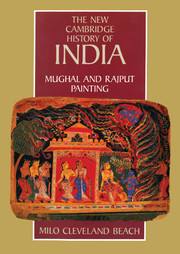Book contents
- Frontmatter
- Introduction
- 1 Painting in North India before 1540
- 2 1540–1580: Painting at Muslim courts
- 3 1580–1600: The new imperial style and its impact
- 4 1600–1660: Mughal painting and the rise of local workshops
- 5 1660–1700: The growth of local styles
- 6 1700–1800: The Dominance of Rajput Painting
- 7 1800–1858: Traditionalism and new influences
- Appendix
- Bibliographical essay
- Index
- The New Cambridge History of India
- References
5 - 1660–1700: The growth of local styles
Published online by Cambridge University Press: 28 March 2008
- Frontmatter
- Introduction
- 1 Painting in North India before 1540
- 2 1540–1580: Painting at Muslim courts
- 3 1580–1600: The new imperial style and its impact
- 4 1600–1660: Mughal painting and the rise of local workshops
- 5 1660–1700: The growth of local styles
- 6 1700–1800: The Dominance of Rajput Painting
- 7 1800–1858: Traditionalism and new influences
- Appendix
- Bibliographical essay
- Index
- The New Cambridge History of India
- References
Summary
Until the eighteenth century, painting for Rajput patrons was almost completely confined to the illustration of familiar, traditional texts - although we have already seen exceptions. Ragamalas, together with episodes from the god Krishna’s life (usually adapted from the Bhagavata Purana), were the most popular subjects for Rajput painters. The standard Ragamala (garland of ragas) is a set of thirty-six paintings depicting possible relationships between a man and a woman, categorized according to the emotional potential of different times of day (for example dawn or sunset) or seasons of the year (pre-monsoon heat, for example, or the rainy season). Each of these is a separate raga, or its variant, a ragini. Vasanta Raga (Plate H), for example, shows the man and woman dancing together in spring. Their physical union is foreshadowed by wild jungle plants, whose rich buds and blossoms are emblems of divine creativity. Nature is still used in such works to intensify the human situation, not to provide a spatial backdrop.
The text of the Ragamala illustrates an element of Hinduism known as bhakti, devotionalism. This is a system whereby the worshipper exists in a direct relationship with a god possessing personal attributes. In both literary and visual presentations, as noted above, this takes the form of romantic, often explicitly sexual, imagery: the worshipper (Lover) longs for union with the divine (the Beloved), and the obliteration of all sense of individuality. By the sixteenth century, numerous bhakti texts had been written in vernaculars, for this was a reactionary movement against priestly control of access to the gods through rituals in Sanskrit.
- Type
- Chapter
- Information
- Mughal and Rajput Painting , pp. 157 - 173Publisher: Cambridge University PressPrint publication year: 1992



